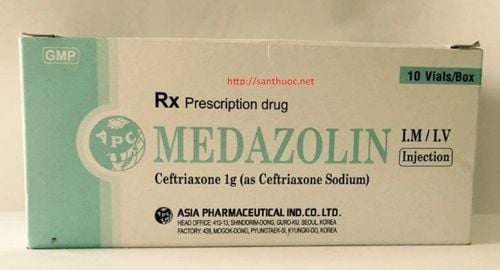This is an automatically translated article.
Chloroxide belongs to the group of drugs that treat parasites, infections, viruses, and fungi. The drug with the main ingredient is Chloramphenicol is made in the form of tablets in boxes or bottles. Let's find out more details about the uses and usage of Chloroxide drug line through the following article.
1. What are the effects of Chloroxide?
Chloroxide is indicated for use in the following cases:
Typhoid fever Paratyphoid salmonella Infection dysentery, brucella infection Urinary tract infection Pneumonia Meningitis Ulcerative colitis Venereal disease Trachoma Inflammation of the skin and skin Skin infections In addition, the drug also has some other effects that have not been mentioned. Patients who use drugs to treat certain diseases need a prescription from a doctor or pharmacist.
2. Dosage and effective use of Chloroxide
2.1. How to use Patients should use the medicine exactly as directed on the product packaging or as directed by a doctor or pharmacist.
Chloroxide is for oral use, should not be used in larger or smaller amounts than indicated. If you have any questions while using the drug, ask your doctor or pharmacist.
2.2. Dosage Adults: 50mg Chloramphenicol/kg. Children: 50-100 mg Chloramphenicol/kg. Infants - Newborns: 25 - 50 mg Chloramphenicol/kg. Divide the dose into 4 equal doses. 2.3. What to do in case of overdose, emergency or missed dose? In the event of an emergency or overdose, the patient should immediately call 911 or go to the nearest local health station. In addition, the patient's family member should record and bring a list of all medications taken, including prescription and non-prescription drugs.
If you forget to take a dose, take it as soon as you remember. However, if it is almost time for the next dose, skip the missed dose and take the next dose as scheduled. Patients should not double the prescribed dose for the purpose of making up for the dose.
The information provided above is not a substitute for medication leaflets and medical professional advice. Patients should always consult with their doctor, pharmacist before deciding to use Chloroxide.
3. Contraindications to the use of Chloroxide
Chloroxide drug is not used for patients with a history of allergy or hypersensitivity to the ingredient Chloramphenicol or any of the excipients in the drug.
4. Side effects when taking the drug Chloroxide
During the use of Clorox, patients may experience some unwanted side effects such as:
Nausea, vomiting Epigastric pain Skin rash Skin rash Neonatal gray syndrome Superinfection Aplastic anemia Cell reduction blood Optic neuritis Peripheral neuritis Urticaria Headache Eye muscle paralysis Confusion This is not a complete list of possible side effects If you have any questions about side effects, ask consult your doctor or pharmacist.
5. Precautions when using Chloroxide
Before taking the drug Chloroxide should note the following:
Inform your doctor about any allergies to any of the ingredients of the drug. List all medications you are taking, including prescription and nonprescription drugs, herbs, and health foods. It is recommended that when using Chloramphenicol during pregnancy, it should be used only when clearly needed. Be sure to discuss the risks and benefits with your doctor before deciding to take a medication. Chloramphenicol must not be used by women who are breast-feeding, as it may harm a young child. Chloramphenicol should not be used in children < 5 months of age. Use with caution in people with impaired liver and kidney function and need to reduce the dose proportionally. During the course of taking the drug, if reticulocytosis, thrombocytopenia/leukopenia, anemia or hematological abnormalities occur, the patient should stop treatment. Patients should immediately discontinue Chlorocid therapy if optic or peripheral neuritis occurs. Because Chloramphenicol can lead to overgrowth of non-susceptible bacteria or fungi.
6. Chloroxide drug interactions
Chloroxide medicine may interact with the following drugs: Chlorpropamide, Tolbutamide, Dicumarol, Phenytoin, Phenobarbital, Vitamin B12, Rifampicin, Iron, Folic acid, food, alcohol and tobacco.
Chloramphenicol may change the way other medicines you are taking or increase the effect of side effects. To avoid drug interactions, it is best for the patient to write a list of all the medicines they are taking for the doctor or pharmacist, to ensure it is safe to take the medicine.
The patient's health condition may affect the use of Chloroxide. Tell your doctor if you have any health problems so that the medicine can be used safely and effectively.
Hopefully with the important sharing about Chloroxide medicine will help the treatment process in patients go well and safely.
Please dial HOTLINE for more information or register for an appointment HERE. Download MyVinmec app to make appointments faster and to manage your bookings easily.













